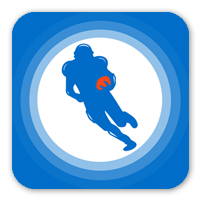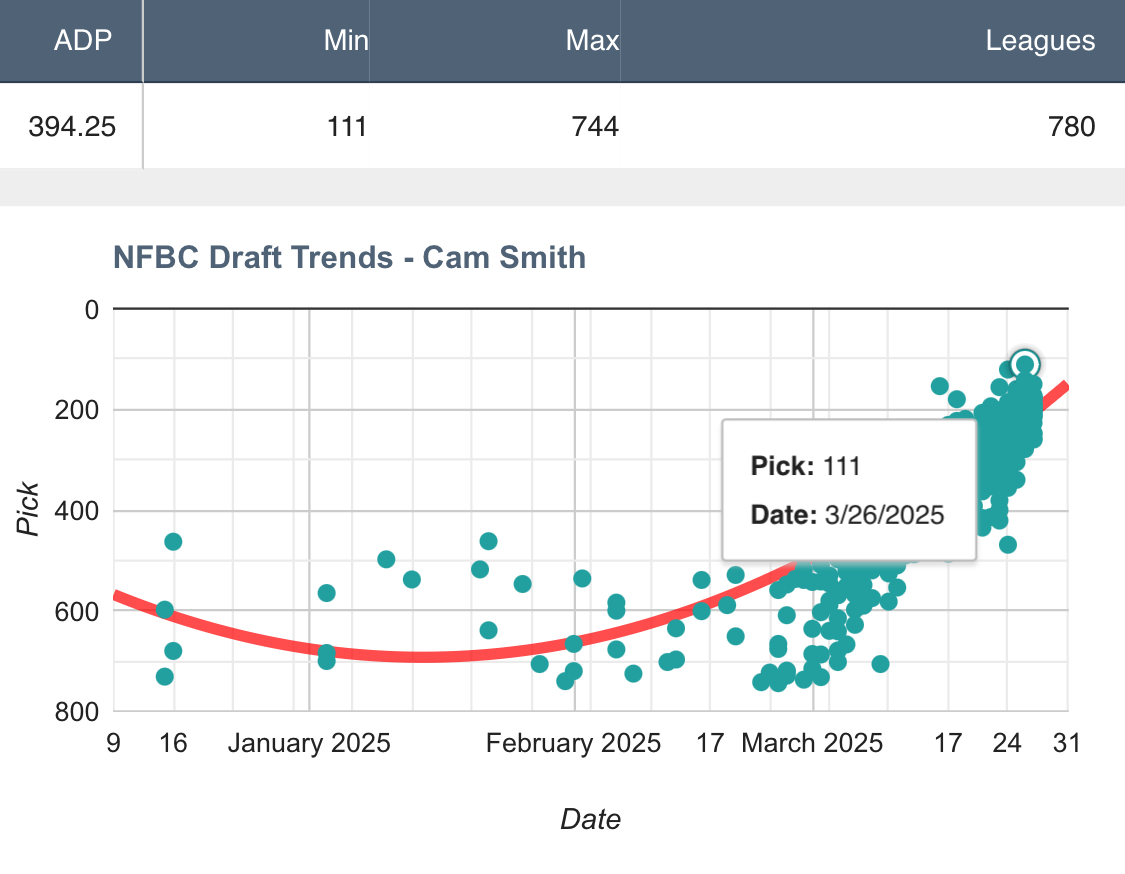Michael's fantasy baseball waiver wire analysis for Week 1 (2025), and whether to buy into MLB hitters and pitchers. Should you avoid these popular names?
Ah, spring has truly sprung. You couldn’t tell from the fans in Cincinnati bundled in Carhartts or the Seattle faithful decked in trident slickers, but baseball began in all its mellow glory on Thursday. Winter is going, in other words. And with it perhaps a good bit of our free agency acquisition budgets (FAAB) as well.
The beginning of a new season is always a perilous time for those budgets, which in most leagues requires management of a $1000 or $100 season budget. That is, if we are not careful as we look to supplement mistakes or simple bad luck that transpired between draft day and the first FAAB period. Forgot to draft a backup for your injury-prone first baseman? Speculated on a closer situation that apparently turned to dust after the opening weekend? It’s time to spackle! (Check out our >>team’s fantasy baseball waiver wire recommendations).
The aim of this weekly column will be to examine a few players each week that are among those being recommended as pickups and decide if there are reasons to put up a caution flag. We call it buyer beware to not always scare you off these players completely, but perhaps to guide you towards more sober bids based on potential limitations of skills or roles. Below are four players who are popular adds recommendations. Let’s dig in and decide how much, or whether, we should invest.
Be sure to check all of our fantasy baseball lineup tools and resources:- Fantasy baseball trade analyzer
- BvP matchups data (Batter vs. Pitcher)
- PvB matchups data (Pitcher vs. Batter)
- Who should I start? Fantasy baseball comparisons
- Daily MLB starting lineups
- Fantasy baseball closer depth charts
- Fantasy Baseball live scoreboard
- Fantasy baseball injury reports
Cam Smith, 3B, Houston Astros
Cam Smith was one of the biggest stories and breakouts of spring training. The barely-22 year old, acquired by Houston in the Kyle Tucker trade, was just drafted last year and has a grand total of 134 plate appearances in the minor leagues, none above Double-A. Smith had a huge spring—batting .342 with four homers (1.129 OPS)—and the Astros outfield situation is beyond thin, so he pushed his way into the opening day lineup, moving from his traditional third base to right field.
We have few doubts that Smith will eventually be a good major leaguer. But once it became clear he would make the team, he was drafted as if it is a certainty. Just look at the draft trends in March at the NFBC:
We have seen more than a few top prospects struggle upon reaching the majors, including Jackson Holliday, who was ranked top three by every prospect outlet last season before a brutal debut and subsequent trip back to the minors. Smith is ranked 58th by MLB Pipeline and 70th overall by FanGraphs. He is not considered quite the same level of can’t-miss youngster.
One of the main problems for hitting prospects is adjusting to the quality of major league pitching. Let’s look at Smith’s spring stats again, but zooming out a little:
.342, 4 HR, 11.6% BB, 25.6% K, 14.7% SwStr
That’s a healthy strikeout number, and it’s supported by a near-15% swinging strike rate. Baseball Reference has an equivalency score for spring training opponents. Smith’s was 6.8; a score of 7 is equivalent to Double-A pitching. So despite the plate discipline as shown by his walk rate (and his prospect reports), Smith was susceptible to punchouts even against pitching far below what he will face while playing for the Astros.
We can also look to projections. The majority of systems are calling for Smith to hit anywhere from .211 at the low end to .244 at the high end. ATC says .233 average, 14 homers, 62 runs, 57 RBI and four steals in 529 PAs, roughly a 16 homer pace.
Those are solid enough numbers, and Smith could certainly beat them and prove to be a major breakout. We aren’t advising not to go after him completely. But there is significant risk that he struggles, at least initially. It may be wise to play it safe and bid a modest amount of your FAAB.
Smith is 46% owned on Yahoo and rising fast. Venerable “oatmeal” producer Ryan McMahon is just 36% rostered (“oatmeal” being a steady veteran who just banks stats for us; hat tip to The Athletic’s Derek Van Riper). Over the last four seasons, McMahon has produced a .245 batting average, 21.5 home runs and 5.4 steals per season. That’s pretty close to what we hope Smith can produce at the top end, except we have much greater confidence that the veteran will reach these numbers.
Kristian Campbell, 2B, Boston Red Sox
We swear we’re not hating on rookies. Campbell, unlike Smith, is both a higher rated prospect (No. 7 by both MLBP and FanGraphs) and had a much more difficult spring training.
Campbell took the prospect world by storm last season. The 2023 fourth round pick hit .330 while going 20/20 and striking out less than 20 percent of the time as he zipped through three levels of the minors. Showing versatility by playing second, shortstop and outfield, Campbell is going to be a really valuable fantasy asset.
Someday (?).
Campbell hit just .167 during spring with a 30.5% strikeout rate. However, his swinging strike rate was just 10.3 percent, which implies he was being too patient. Indeed he maintained a solid 17% walk rate in exhibition play. Like Smith, Campbell had just a 6.8 Opponent Quality score—i.e., on average he faced Double-A pitching.
Well the Red Sox saw enough of something in their internal evaluations to promote Campbell. This was announced near the end of camp:
The writing has been on the wall for weeks. Kristian Campbell is a big leaguer: https://t.co/gYFA1EfLvC
— Chris Cotillo (@ChrisCotillo) March 24, 2025
As that post makes clear, even moderately interested observers could tell that Campbell was getting every opportunity to make the team. However, once it became official his ADP rocketed from the 300s into the top 200.
Campbell’s projections are better and more fantasy-friendly than Smith’s. ATC has Campbell for a .263 average with 13 home runs and 15 steals in 522 PAs (121 games). That’s a 15/17 pace.
As with Smith, there is a boring veteran alternative available to Campbell, who is 38 percent rostered on Yahoo as of this writing. Brendan Donovan is a proven hitter who should play every day for the Cardinals; he is 54 percent rostered on Yahoo. Donovan has batted an even .280 over his last 1491 PAs and is eligible at both second and outfield. Campbell likely steals more bases but we’d be thrilled if he hits like Donovan right away. Campbell may be used in the outfield eventually, but he also may not. There is a lot we don’t know with his entire outlook this season.
As with Smith, we are not saying you shouldn’t go after Campbell at all. Just remember there is some risk of the unknown here, which could include his performance cratering and a trip back to the minors. The Sox are clearly trying to compete this year. If you’re in a shallow league and can add Campbell cheaply, go for it and see if he’s the next Julio Rodriguez. In deeper leagues he is likely drafted already. But if not, it will cost a pretty penny to acquire him in FAAB. Just remember the Jackson Holliday lesson before you commit 30 percent or more of your FAAB dollars.
Miguel Vargas, 3B/OF, Chicago White Sox
Vargas is no longer a rookie, but he’s a young player with just 595 plate appearances in the majors so he fits our theme. As with Smith and Campbell, Vargas should get plenty of run for the White Sox after leading off on Opening Day. In fact given the state of the South Siders he should get even more playing time.
Vargas hit leadoff on Opening Day and went 2-4 with a double and two RBI. That’s the good.
Vargas the prospect was well regarded for his hit tool; being part of the Dodgers system at the time didn’t hurt either. But he has simply not hit the ball hard in the majors. Last year he had a feeble 86.2 average exit velocity, 4.2 percent barrel rate and 26.3 hard hit percentage.
His double on Thursday was struck at just 75.3 MPH and fell into a defensive gap (.150 xBA). Moreover, Vargas held just a 85.3 average EV in spring Statcast-tracked games. That’s eeeily similar to last year’s uninspired number. It may be too early to write him off for all time, but Vargas is 25 now. Not a finished product but not a fresh faced youth (in baseball terms) either.
As a very deep league addition, Vargas could be a useful accumulator. Last season he struck out 24 percent of the time but with just an 8 percent swinging strike rate; if he gets more aggressive he could post a solid batting average.
So in very deep leagues Vargas is worth a small bid, especially with third base and outfield eligibility and at least a temporary role at leadoff (Mike Tauchman, who was set to bat first for the ChiSox, is on the IL). However, if looking for a third baseman in a shallow league, Brett Baty is also potentially available (8 percent on Yahoo to Vargas’ 3 percent)—and has significantly more upside. Baty is playing second base in a strong side platoon so will also add another eligibility. In the outfield we would prefer Pavin Smith (2 percent) or Trevor Larnach (3 percent) over Vargas.
Justin Slaten, RP, Boston Red Sox
Slaten will be highly pursued in FAAB this week after notching the Red Sox’s first save on Opening Day. Saves are saves are saves after all, and Slaten already has one. That might be a mistake. Not the add necessarily, but the “highly” part.
Way back in October, we got a report that with Liam Hendriks working back from multiple injuries, Red Sox manager Alex Cora had mentioned Slaten as a potential option to close games in 2025. That piqued our interest.
Then the Sox signed Aroldis Chapman, who happens to rank second in career saves among active players with 335, though he hadn’t been a strict capital-C closer in recent years. Cora named him Boston’s closer near the end of spring training.
Slaten, a Rule 5 pick, performed brilliantly last season, pitching to a 2.93 ERA and 1.01 WHIP (14% SwStr) in a setup role for Boston while also notching two saves. He wields a four-pitch mix and exhibited especially great control (4% walk rate).
But here’s the thing: while all his pitches graded as plus by stuff models, Slaten leads with a cutter, not an overpowering fastball. His 26% strikeout rate was good, but not elite for a closer.
Chapman, on the other hand, still throws gas, sitting 99 with his fastball (99th percentile) and even touching 105. He also comes with the walk rates typically expected from hard-throwing relievers (almost 15 percent in 2024). But right around the time of his signing, Sox chief baseball officer Craig Breslow explained that the elite velocity is exactly what they were seeking:
Although Cora named Chapman the primary closer, he also mentioned he may use the power southpaw outside the ninth inning. In fact, he even predicted that Chapman could pitch the eighth as soon as Opening Day: “But if Corey Seager leads off the eighth, he could be used in the eighth. And there's certain times he's gonna pitch the eighth, but most [often], he'll pitch the ninth inning.”
That exact scenario came to pass Thursday, as Chapman was brought in to face Seager, who was due up first in the eighth of a tie game. Slaten then got the ninth to cleanly close out a win over Texas. Cora said afterwards such situations “are for Chapman” and praised Slaten, but did not indicate a shift in overall approach.
Given the context here, we should pump the brakes on Slaten bids a little bit. Chapman will get the majority of saves outside of the odd situation. Slaten is still worth an add as he should collect at least some saves (as should Garrett Whitlock), but we should keep the bids reasonable. Splurging 20 percent or more in FAAB doesn’t make much sense for eight or even ten saves.
In fact, grabbing Whitlock—who is excellent in his own right—for cheap might be the sharper play. He will often pitch multiple innings, giving him an avenue to wins and more strikeouts than we likely see from Slaten. If Chapman goes down with injury or walks his way out of the role, we don’t really know who would be next up as primary closer. It might even be Whitlock.
Download Our Free News & Alerts Mobile App
Like what you see? Download our updated fantasy baseball app for iPhone and Android with 24x7 player news, injury alerts, sleepers, prospects & more. All free!






 RADIO
RADIO


























